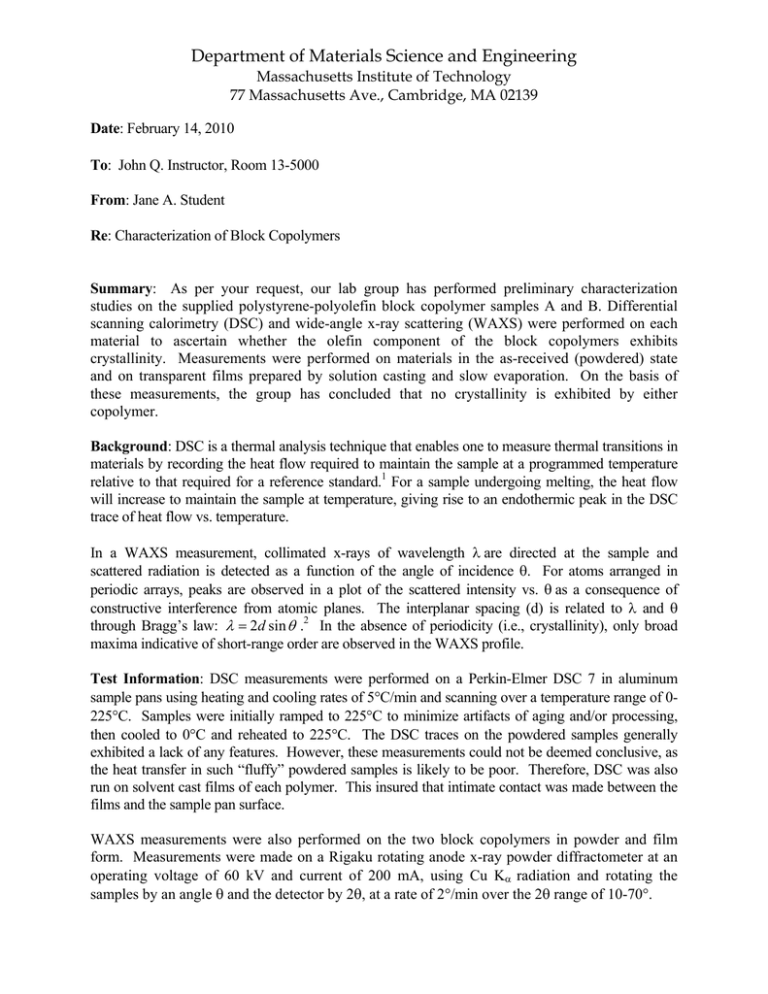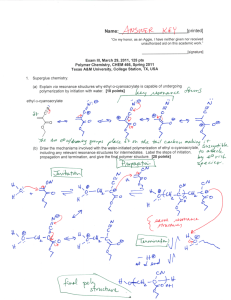Document 13554150
advertisement

Department of Materials Science and Engineering Massachusetts Institute of Technology 77 Massachusetts Ave., Cambridge, MA 02139 Date: February 14, 2010 To: John Q. Instructor, Room 13-5000 From: Jane A. Student Re: Characterization of Block Copolymers Summary: As per your request, our lab group has performed preliminary characterization studies on the supplied polystyrene-polyolefin block copolymer samples A and B. Differential scanning calorimetry (DSC) and wide-angle x-ray scattering (WAXS) were performed on each material to ascertain whether the olefin component of the block copolymers exhibits crystallinity. Measurements were performed on materials in the as-received (powdered) state and on transparent films prepared by solution casting and slow evaporation. On the basis of these measurements, the group has concluded that no crystallinity is exhibited by either copolymer. Background: DSC is a thermal analysis technique that enables one to measure thermal transitions in materials by recording the heat flow required to maintain the sample at a programmed temperature relative to that required for a reference standard.1 For a sample undergoing melting, the heat flow will increase to maintain the sample at temperature, giving rise to an endothermic peak in the DSC trace of heat flow vs. temperature. In a WAXS measurement, collimated x-rays of wavelength λ are directed at the sample and scattered radiation is detected as a function of the angle of incidence θ. For atoms arranged in periodic arrays, peaks are observed in a plot of the scattered intensity vs. θ as a consequence of constructive interference from atomic planes. The interplanar spacing (d) is related to λ and θ through Bragg’s law: λ = 2d sin θ .2 In the absence of periodicity (i.e., crystallinity), only broad maxima indicative of short-range order are observed in the WAXS profile. Test Information: DSC measurements were performed on a Perkin-Elmer DSC 7 in aluminum sample pans using heating and cooling rates of 5°C/min and scanning over a temperature range of 0 225°C. Samples were initially ramped to 225°C to minimize artifacts of aging and/or processing, then cooled to 0°C and reheated to 225°C. The DSC traces on the powdered samples generally exhibited a lack of any features. However, these measurements could not be deemed conclusive, as the heat transfer in such “fluffy” powdered samples is likely to be poor. Therefore, DSC was also run on solvent cast films of each polymer. This insured that intimate contact was made between the films and the sample pan surface. WAXS measurements were also performed on the two block copolymers in powder and film form. Measurements were made on a Rigaku rotating anode x-ray powder diffractometer at an operating voltage of 60 kV and current of 200 mA, using Cu Kα radiation and rotating the samples by an angle θ and the detector by 2θ, at a rate of 2°/min over the 2θ range of 10-70°. Test Results: DSC measurements on block copolymer A showed no endothermic or exothermic peaks that would be consistent with melting or crystallization, respectively; however, a change in slope was observed in the temperature range of 34-37°C on both heating and cooling (Attachment 1), which might be attributable to the glass transition of the polystyrene component of the block copolymer. While polystyrene normally exhibits a glass transition near 100°C, no such observation in the range of 100°C was made. It can be conjectured that the Tg of polystyrene might be lower in these samples due to the short length of the polystyrene end blocks and some degree of intermixing between this glassy component and other low Tg components of the block copolymer. DSC measurements on the sample B film similarly showed no endothermic or exothermic peaks characteristic of polyethylene melting or crystallization. Here, a change in slope was observed on cooling at ~138°C and on reheating at 167°C (Attachment 2). Both the nature of this transition and the temperature range in which it is observed are inconsistent with what one would expect for polyethylene melting/crystallization. The trace looks more characteristic of a glass transition or second-order phase transition, while the temperature range in which it is observed is substantially higher than one would expect for the melting transition of olefin-containing block copolymer materials incorporating crystallizing polyethylene blocks.3 The transition is also above the melting point of high molecular weight linear polyethylene (Tm≈138°C). The observed transition in the DSC trace is also too high to be attributable to a glass transition, based on the expected composition of the copolymers (polystyrene, the high Tg block, has a reported glass transition near 100°C). It may instead be the order-disorder transition of the block copolymer. WAXS experiments provided further evidence that no measurable crystalline polyethylene phase is present in either of the samples. Samples exhibited only a broad maximum at 2θ≈20° characteristic of the short-range order always present in amorphous hydrocarbon polymers (Attachment 3). No sharp peaks characteristic of Bragg diffraction were found at 2θ≈21° or 24° that would correspond to the two most intense reflections for crystalline polyethylene [the (110) and (200) reflections];4 other higher-order reflections for polyethylene were also absent, and no other sharp peaks indicative of Bragg diffraction and crystallinity were found over the 2θ range scanned. Conclusions and Recommendations: On the basis of these results, we have concluded that block copolymers A and B do not exhibit crystallinity. Further testing may be performed to ascertain the origin of the thermal signature observed in sample A at ~35°C and sample B at 138° C. Please feel free to contact me in the event that further details regarding the experimental measurements or data interpretation are required. References 1. A.J. Pasztor, ‘Thermal Analysis Techniques” in Handbook of Instrumental Techniques for Analytical Chemistry, F. Settle, ed. (Upper Saddle River, NJ: Prentice Hall PTR, 1997) p. 911. 2. B.D. Cullity, Elements of X-ray Diffraction, 2nd ed. (Menlo Park, CA: Addison-Wesley, 1978). 3. D.J. Quiram and R.A. Register, Macromolecules 30, 4551 (1997). 4. R.J. Young and P.A. Lovell, Introduction to Polymers, 2nd ed. (Cheltenham, UK: Stanley Thornes, 1991), p. 266. 2




